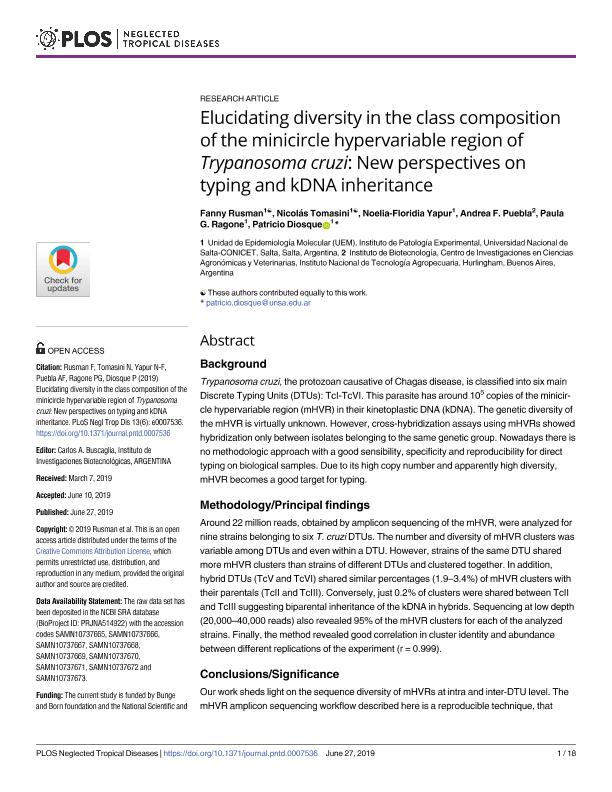Mostrar el registro sencillo del ítem
dc.contributor.author
Tomasini, Nicolás

dc.contributor.author
Rusman, Fanny

dc.contributor.author
Floridia Yapur, Noelia Aldana del Rosario

dc.contributor.author
Puebla, Andrea Fabiana

dc.contributor.author
Ragone, Paula Gabriela

dc.contributor.author
Diosque, Patricio

dc.date.available
2020-12-15T21:09:31Z
dc.date.issued
2019
dc.identifier.citation
Tomasini, Nicolás; Rusman, Fanny; Floridia Yapur, Noelia Aldana del Rosario; Puebla, Andrea Fabiana; Ragone, Paula Gabriela; et al.; Elucidating diversity in the class composition of the minicircle hypervariable region of Trypanosoma cruzi: New perspectives on typing and kDNA inheritance; Public Library of Science; Neglected Tropical Diseases; 13; 6; 2019; 1-18
dc.identifier.issn
1935-2735
dc.identifier.uri
http://hdl.handle.net/11336/120539
dc.description.abstract
Background Trypanosoma cruzi, the protozoan causative of Chagas disease, is classified into six main Discrete Typing Units (DTUs): TcI-TcVI. This parasite has around 105 copies of the minicircle hypervariable region (mHVR) in their kinetoplastic DNA (kDNA). The genetic diversity of the mHVR is virtually unknown. However, cross-hybridization assays using mHVRs showed hybridization only between isolates belonging to the same genetic group. Nowadays there is no methodologic approach with a good sensibility, specificity and reproducibility for direct typing on biological samples. Due to its high copy number and apparently high diversity, mHVR becomes a good target for typing. Methodology/Principal findings Around 22 million reads, obtained by amplicon sequencing of the mHVR, were analyzed for nine strains belonging to six T. cruzi DTUs. The number and diversity of mHVR clusters was variable among DTUs and even within a DTU. However, strains of the same DTU shared more mHVR clusters than strains of different DTUs and clustered together. In addition, hybrid DTUs (TcV and TcVI) shared similar percentages (1.9–3.4%) of mHVR clusters with their parentals (TcII and TcIII). Conversely, just 0.2% of clusters were shared between TcII and TcIII suggesting biparental inheritance of the kDNA in hybrids. Sequencing at low depth (20,000–40,000 reads) also revealed 95% of the mHVR clusters for each of the analyzed strains. Finally, the method revealed good correlation in cluster identity and abundance between different replications of the experiment (r = 0.999). Conclusions/Significance Our work sheds light on the sequence diversity of mHVRs at intra and inter-DTU level. The mHVR amplicon sequencing workflow described here is a reproducible technique, that allows multiplexed analysis of hundreds of strains and results promissory for direct typing on biological samples in a future. In addition, such approach may help to gain knowledge on the mechanisms of the minicircle evolution and phylogenetic relationships among strains.
dc.format
application/pdf
dc.language.iso
eng
dc.publisher
Public Library of Science

dc.rights
info:eu-repo/semantics/openAccess
dc.rights.uri
https://creativecommons.org/licenses/by-nc-sa/2.5/ar/
dc.subject
TRYPANSOMA CRUZI
dc.subject
MINICIRCLES
dc.subject
LINEAGES
dc.subject.classification
Genética y Herencia

dc.subject.classification
Ciencias Biológicas

dc.subject.classification
CIENCIAS NATURALES Y EXACTAS

dc.title
Elucidating diversity in the class composition of the minicircle hypervariable region of Trypanosoma cruzi: New perspectives on typing and kDNA inheritance
dc.type
info:eu-repo/semantics/article
dc.type
info:ar-repo/semantics/artículo
dc.type
info:eu-repo/semantics/publishedVersion
dc.date.updated
2020-05-19T19:45:54Z
dc.journal.volume
13
dc.journal.number
6
dc.journal.pagination
1-18
dc.journal.pais
Estados Unidos

dc.journal.ciudad
San Francisco
dc.description.fil
Fil: Tomasini, Nicolás. Consejo Nacional de Investigaciones Científicas y Técnicas. Centro Científico Tecnológico Conicet - Salta. Instituto de Patología Experimental. Universidad Nacional de Salta. Facultad de Ciencias de la Salud. Instituto de Patología Experimental; Argentina
dc.description.fil
Fil: Rusman, Fanny. Consejo Nacional de Investigaciones Científicas y Técnicas. Centro Científico Tecnológico Conicet - Salta. Instituto de Patología Experimental. Universidad Nacional de Salta. Facultad de Ciencias de la Salud. Instituto de Patología Experimental; Argentina
dc.description.fil
Fil: Floridia Yapur, Noelia Aldana del Rosario. Consejo Nacional de Investigaciones Científicas y Técnicas. Centro Científico Tecnológico Conicet - Salta. Instituto de Patología Experimental. Universidad Nacional de Salta. Facultad de Ciencias de la Salud. Instituto de Patología Experimental; Argentina
dc.description.fil
Fil: Puebla, Andrea Fabiana. Instituto Nacional de Tecnología Agropecuaria; Argentina
dc.description.fil
Fil: Ragone, Paula Gabriela. Consejo Nacional de Investigaciones Científicas y Técnicas. Centro Científico Tecnológico Conicet - Salta. Instituto de Patología Experimental. Universidad Nacional de Salta. Facultad de Ciencias de la Salud. Instituto de Patología Experimental; Argentina
dc.description.fil
Fil: Diosque, Patricio. Consejo Nacional de Investigaciones Científicas y Técnicas. Centro Científico Tecnológico Conicet - Salta. Instituto de Patología Experimental. Universidad Nacional de Salta. Facultad de Ciencias de la Salud. Instituto de Patología Experimental; Argentina
dc.journal.title
Neglected Tropical Diseases

dc.relation.alternativeid
info:eu-repo/semantics/altIdentifier/url/https://journals.plos.org/plosntds/article?id=10.1371/journal.pntd.0007536
dc.relation.alternativeid
info:eu-repo/semantics/altIdentifier/doi/http://dx.doi.org/10.1371/journal.pntd.0007536
Archivos asociados
